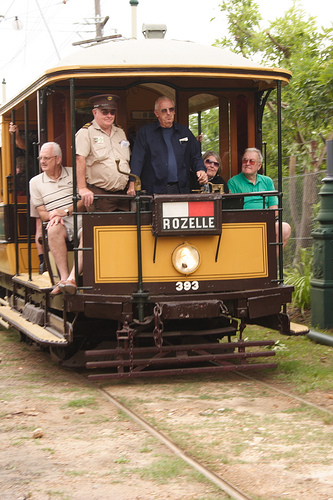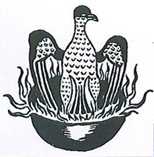|
ON
a balmy winter's Sunday in 1922 Richard Lovatt Somers,
a visiting English writer and his wife Harriett (aka DH
Lawrence and his wife Frieda) took a "ferry steamer"
across Sydney Harbour to Manly, where, as Lawrence relates
in Kangaroo, they wandered up the street which
looked "like a bit of Margate lined with sea-side
shops and restaurants" to the ocean beachfront where
they ate some lunch before going back to an "eating-house"
where they warmed themselves with some soup before setting
off by tram for Narrabeen.
"They
sat on the tram-car and ran for miles along a coast"
before arriving at the terminus near Narrabeen Lagoon
(the tram shed still exists on that same spot) before
alighting and walking along the sandy road beside the
Lagoon towards the ocean.
Lawrence and
Frieda sat on the sand and ate some pears and watched
the lazy antics of some locals, paddling and playing.
Somers couldn't get over the Australian men's muscular
legs: "They seemed to run to leg, these people."
Unlike their
later trip to Thirroul, which was by train, a mode of
transport which Lawrence describes in some detail, he
didn't describe the tram they took to Narrabeen.
But I know
what it looked like - for I saw it, (see photograph above),
or one of its class, at the Vintage Tramway Festival Open
Day on Sunday February 22, 2009, at the Sydney Tramway
Museum at Loftus, when a small contingent of the DH Lawrence
Society of Australia went tram-spotting and held a BBQ.
The "Lawrence"
tram was not on public display that day but we were privileged
to get a private view of it. It was an O 1111-class, one
of nine that plied the route from Manly to the terminus
at Narrabeen and back to Manly in 1922.
It is a green
and cream semi- "toast rack" model with varnished
wood seats. The front and rear sections (the rear became
the front and vice versa as the tram went up-and-down
the line to the terminus and back to Manly) are open,
allowing passengers to hop on and off easily. The rest
of the tram has sliding doors. (for another photo of the
tram see over
page with DHL Society Vice-President, Robert
Darroch, Secretary, Sandra Jobson Darroch and Archivist
John Ruffels.)
We also witnessed
a rare event: the official ceremony for the welcoming
of the sole surviving veteran J tram 675 (see photo over
page ).
John Lacey, our DHL Society President, is a serious steam
train buff but his knowledge also encompasses trams. About
the J tram, he says: "47 small four-wheel J Class
were built in Edwardian times to operate the busy tram
route along King St. Sydney through Kings Cross and out
to Watson's Bay. It was one of Australia's busiest tram
routes and also one of the most demanding, with sharp
curves and steep grades. When modern corridor trams arrived
in 1933, the elderly J Class were withdrawn and scrapped.

|
Setting
off into the Royal National Park
on the veteran R393
|
|
|
"Now,
75 years later and following a four-year restoration the
J train made its second debut."
After the unveiling ceremony, where a ribbon was cut, the
various trams were ready to take visitors for a ride. We
sat at the very front next to the driver on a F393 dating
from 1902 and set off with a load of passengers (see photo
over
page).
We held up
the admiring traffic as we crossed over the Princes Highway
and then entered the Royal National Park, travelling along
an old railway track through the bush (the tram and train
gauge tracks were the same dimensions).
Back at the
exhibition there was a whole lot more to enjoy with up
to seven century-old trams in operation throughout the
day, including C 290 of 1896, C 29 of 1898, F 393 of 1902,
N 728 of 1906, as well as many more trams on display in
the Museum..
These trams are surviving relics of Sydney's once thriving
tram-network, which at its height, John Lacey relates,
was the largest tramway system in Australia.
Lawrence had
quite a lot to do with trams over the years. Not only
did he travel to Narrabeen on one - he (or his alter ego
Somers) also took a tram from Cremorne Wharf on Sydney's
north side to Florence Avenue.
This tram
was either the same model as the famous Bondi tram or
the other one that went to Bondi via Bellevue Hill. (By
the way, the legendary Bondi tram "shot through"
at weekends because its passengers only wanted to get
to Bondi Beach - as fast as possible - hence it cut out
all the intermediate stops and thus gathered speed.)
Lawrence,
in his youth, living at Eastwood, often travelled on the
local double-decker colliery trams that plied up-and-down
the hills between the Midlands villages.
In a lively
short story, "Tickets Please", Lawrence describes
the precarious journeys of "the most dangerous tram
service in England as the authorities themselves declare
with pride".
The drivers
were young men medically unfit to join in World War 1,
but daredevils nonetheless, and the conductors were study
local girls with sharp tongues and warm wit.
"The
ride becomes a steeplechase. Hurray!" Lawrence writes,
"we have leapt in a clear jump over the canal bridge
- now for the four-lane corner. With a shriek and a trail
of sparks we are clear again. To be sure, a tram often
leaps the rails - but what matter! It sits in a ditch
till other trams come to haul it out…"
This short
story, with a lead character named John Thomas, is a joy
to read.
Lawrence certainly had a soft spot for trams.
Click
HERE
to see more photos of the TRAMS
.
|


